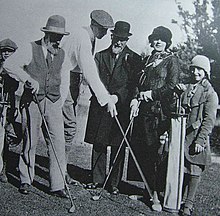Henri-Pierre Roché
Henri-Pierre Roché (born May 28, 1879 in Paris , † April 9, 1959 in Meudon ) was a French writer and art collector .
life and work
Roché was raised by his mother alone after his father died very young. After graduating from high school, he began to study political science, but quickly gave up because he was more drawn to painting. He studied drawing in Paris, which he did not finish. After the unfinished studies, he went traveling and began collecting art. He also translated Chinese poems into French. They were set to music by composers such as Georges Auric , Albert Roussel and Fred Barlow .

In the years before the First World War he was friends with numerous artists living in Paris. He mediated Gertrude Stein's first meeting with Pablo Picasso , whom he later brought to the USA and made known there. His friends included Francis Picabia , Constantin Brâncuși , Marcel Duchamp and Wols . Roché is considered the first collector of Wols watercolors. His closest friend at this time, however, was the young German writer Franz Hessel . He later set a lasting monument to this friendship with his novel Jules and Jim . In 1962, the film by the director François Truffaut , Jules and Jim , was shot.
In 1914 he was checked out by the French army as unfit during the mobilization , but was arrested for two weeks on suspicion of espionage due to a denunciation. It was the letters from his German friend Hessel that had put him under suspicion. In 1916 he left France and lived in New York , where he published the Dadaist magazine The Blind Man together with Marcel Duchamp and Beatrice Wood in 1917 .
In New York, Roché worked primarily as an art dealer . Nevertheless, he also found time to write. The first volumes of short stories appeared in 1916 and 1920. On July 11, 1920, he and Claire and Yvan Goll went on a business trip to Germany lasting several months. There he met Carl Sternheim , who translated one of his works, the publisher Hermann von Wedderkop , the Spartacist Carl Einstein and the painters Rudolf Levy and Otto von Wätjen .
Roché did not write his first novel Jules and Jim until the age of 73. He gained fame primarily through the film adaptation of this novel and his second work Two Girls from Wales and the love of the continent by François Truffaut , whom he met shortly before his death to discuss the first film project Jules and Jim . He didn't live to see the premiere of the film and so he remained rather an unknown during his lifetime.
1977 appeared posthumously as a fragment Victor , a novel about Marcel Duchamp, with a foreword by René Clair . It was published by the Center national d'art et de culture Georges Pompidou , Paris.
literature
- Henri-Pierre Roché: Jules and Jim . With a foreword by François Truffaut . From the French by Peter Ruhff. Gruner & Jahr, Hamburg 2010, ISBN 978-3-570-90728-3 (The French original edition was published in 1953.)
- Henri-Pierre Roché: Victor. A novel . With a foreword by Jean Clair. Translated from the French by Simon Werle, Schirmer – Mosel, Munich 1986, ISBN 3-888-14211-3
- Hannelore Schulte & Wolfgang Schwarzer: François Truffaut and H.-PR - The true story about "Jules and Jim" ; also as a lecture on September 3, 2009 in the VHS Duisburg
Web links
- Literature by and about Henri-Pierre Roché in the catalog of the German National Library
- Henri-Pierre Roché in the Internet Movie Database (English)
| personal data | |
|---|---|
| SURNAME | Roché, Henri-Pierre |
| BRIEF DESCRIPTION | French writer and art collector |
| DATE OF BIRTH | May 28, 1879 |
| PLACE OF BIRTH | Paris |
| DATE OF DEATH | April 9, 1959 |
| Place of death | Meudon |